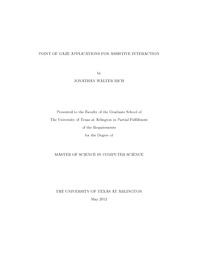
ATTENTION: The works hosted here are being migrated to a new repository that will consolidate resources, improve discoverability, and better show UTA's research impact on the global community. We will update authors as the migration progresses. Please see MavMatrix for more information.
Show simple item record
| dc.contributor.author | Rich, Jonathan Walter | en_US |
| dc.date.accessioned | 2012-07-25T19:09:18Z | |
| dc.date.available | 2012-07-25T19:09:18Z | |
| dc.date.issued | 2012-07-25 | |
| dc.date.submitted | January 2012 | en_US |
| dc.identifier.other | DISS-11674 | en_US |
| dc.identifier.uri | http://hdl.handle.net/10106/11082 | |
| dc.description.abstract | Eye tracking has many useful applications in human-machine interfaces and assistive technologies. Traditional input methods, such as the keyboard and mouse, are not practical in certain situations and can be completely ineffective for users with physical disabilities. Since many computing interfaces contain a strong visual component, it follows that knowledge of the user's point of gaze (PoG) can be extremely useful. Several approaches to PoG tracking have been described with various results and associated costs. Commercially available tracking devices have proven to be very useful for some disabled users, though often the systems can be cost prohibitive. Many computing applications could be enhanced via reliable yet inexpensive PoG tracking devices. Ordinary consumers as well as the disabled could greatly benefit from the combined technologies.In the past there has been a void in a publicly available eye tracking dataset which combined the information of the head position with the eye tracking video and gaze points. Such a dataset was needed as a standard for comparing accuracy of methods. Many eye tracking devices did not account for head tracking and relied on users remaining still relative to the monitor. Systems which do not allow shift in head position work better in theory than in reality due to inevitable head movement. A low-cost head and eye tracking solution was needed to show such devices are practical without being cost prohibitive.Presented in this thesis is a new publicly available dataset, and a low-cost head and eye tracking solution. To further environment interaction, a structured light sensor was added to the eye tracking solution. A structured light sensor allows for depth mapping of the environment. Combining the depth mapping with the user's PoG offers more efficient and reliable model segmentation. Ultimately the goal of such a system is to allow for natural human-machine interaction with assistive technologies. | en_US |
| dc.description.sponsorship | Makedon, Fillia | en_US |
| dc.language.iso | en | en_US |
| dc.publisher | Computer Science & Engineering | en_US |
| dc.title | Point Of Gaze Applications For Assistive Interaction | en_US |
| dc.type | M.S. | en_US |
| dc.contributor.committeeChair | Makedon, Fillia | en_US |
| dc.degree.department | Computer Science & Engineering | en_US |
| dc.degree.discipline | Computer Science & Engineering | en_US |
| dc.degree.grantor | University of Texas at Arlington | en_US |
| dc.degree.level | masters | en_US |
| dc.degree.name | M.S. | en_US |
Files in this item
- Name:
- Rich_uta_2502M_11674.pdf
- Size:
- 9.691Mb
- Format:
- PDF
This item appears in the following Collection(s)
Show simple item record


